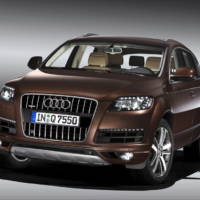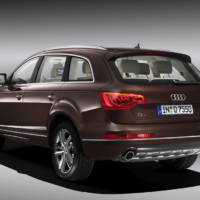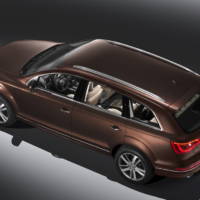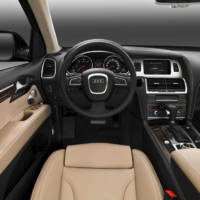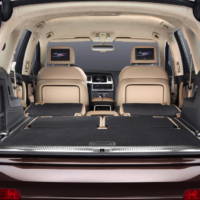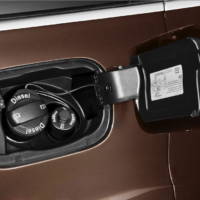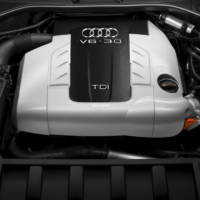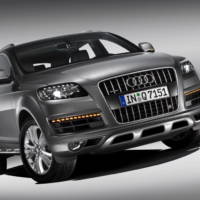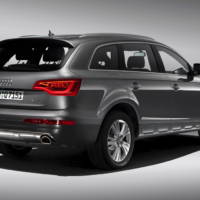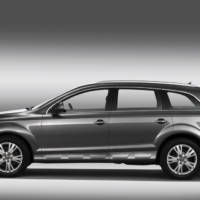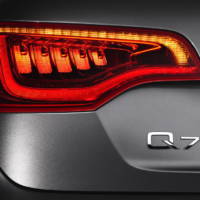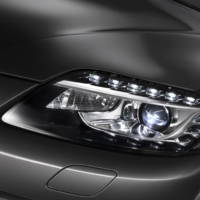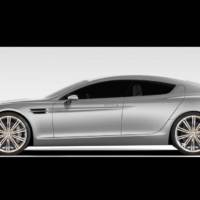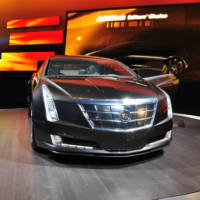Audi has just released photos and details showcasing their facelifted Q7 SUV. At the exterior you can easily notice the redesigned front and rear lights including the LED’s as well as the updated front and rear bumpers that contain chromed finishes plus the new rims. The 2010 Audi Q7 with facelift will be available with two new paint colors, Teak Brown and Graphite Gray that will match interior elements like the also new Ventilated Premium Cricket leather seats. As for the upgraded gadgets the most notable would be the third generation MMI system with joystick controlled 3D navigation, and the voice enabled SIRIUS satellite radio.
So far we don’t have details regarding any new engines, but things might change when the German automaker will also announce the facelifted 2010 Audi Q7 price.
Audi press release :
2010 Audi Q7 Product Improvement Quick Reference: USA Data
VERSION DATE: April 14, 2009
INFO IS SUBJECT TO CHANGES AND UPDATES PRIOR TO LAUNCH
Product Improvement Summary
– Exterior updates:
– New front lighting design and LED daytime running lights
– New full LED rear lights (LED running lights, brake lights, and turn signals)
– Added chrome finishes on bumpers, door panels, and door handles
– Two-tone exterior mirrors
– New wheel designs
– Updated front/rear bumpers
– New paint colors (Teak Brown, Graphite Gray)
– Rear tailgate has new shape for worldwide license plate acceptance
– Interior updates:
– Ventilated Premium Cricket leather front seats
– Ambient interior door lighting and additional chrome enhancements on switchgear
– Additional wood decorative inlay on passenger side dash
– Infotainment:
– New MMI navigation system – third generation MMI shows latest evolution of 3D navigation, joystick control for navigation map destination finding, updated graphical clarity, SIRIUS artist/title preview, SIRIUS traffic-based navigation, voice-based destination input control, and voice inputs such as “I’m hungry,” “I need money,” “I need gas” and “I need coffee” that will point to closest options within current vicinity.
– Launch Timing and Pricing:
– Audi Q7 with product improvement features launches in Fall 2009 as a 2010 model year vehicle. Pricing will be announced closer to launch.
FSI gasoline direct injection summary
– Audi FSI direct injection gasoline technology was born in the R8 Le Mans-winning sports car found on racetracks from 2000-2005, with its first U.S. application in the 2005 A6 3.2 FSI V6 sedan launching in late 2004 calendar year. Using many of the same principles as TDI clean diesel technology, its high compression ratios allow for more power and torque with better fuel economy, while increasing performance levels from previous engine generations. Audi Q7’s 3.6 FSI V6 engine and its 4.2 FSI V8 engines complement the TDI clean diesel engine joining the Audi Q7 family in April 2009.
TDI clean diesel Summary
– Audi TDI clean diesel is clean, quiet, efficient, and fast. Customers buy this technology because it saves them time and adds convenience because of its city/highway range, all in a very clean and high-tech manner.
– Audi TDI clean diesel engines are held to the same emissions standards as gasoline engines in the U.S., plus offer the advantages of 30% better fuel economy than V6 gasoline engines of similar displacement. Audi recommends premium gasoline fuel for FSI direct injection engines, with similar pricing for ultra low sulfur diesel fuel available in the U.S.
– With 25 mpg highway and over 600 highway miles of range, Audi has chosen the Audi Q7 to launch diesel to demonstrate the best of qualities of fuel efficiency and technology in a vehicle segment that is not known for these attributes.
– Audi has been preparing the U.S. market for TDI clean diesel by racing the R10 TDI LMP1 prototype for the past three seasons within the American Le Mans series, with proven and equally consistent victories for all three competing years at the famed 24 Hours of Le Mans endurance race. The 650 hp and 800 lb-ft of torque within the R10 TDI is proof of Audi endurance, reliability, performance, and high levels of technology. It has always used the futuristic and high-potential GTL (gas-to-liquid) clean diesel fuel and has experimented with BTL (biomass-to-liquid) fuel in the 2008 24 Hours of Le Mans endurance race. The new R15 TDI sports car with a V10 TDI clean engine won its maiden competition at the March 2009 12 Hours of Sebring endurance race. Preparations are well under way for its first 24 Hours of Le Mans racing debut in June 2009.
– Audi TDI clean diesel development since 1989: output up 100%, torque up 70%, cleaner by 95%, particulates reduced by 98%.
Market
– Key competitors are BMW X5 xDrive30i, xDrive35d, and xDrive48i and Mercedes GL320 BlueTEC, GL450, and GL550.
Why TDI clean diesel in the United States in 2009 with the new Audi Q7 TDI?
– Audi has achieved Bin5/ULEV (ultra low emissions vehicle) II 50-state status. Audi clean diesel is measured on the same emissions basis as gasoline-based engines, but with 30% better fuel efficiency.
– Advantages include very American driving aspects such as long range with over 600 highway miles between fueling stops for a convenient lifestyle, off-the-line power/torque, smooth and quiet ride.
– When comparing diesel fuel prices 1:1 to Audi-recommended Super unleaded gasoline, the price differential will pay for itself over a few years time, and even sooner if resale value, and the Alternative Motor Vehicle credit is taken into consideration.
– Clean diesel is progressive, in line with Audi worldwide brand values, with its advanced technology and performance without sacrificing efficiency.
Design
– Sporty coupe-like roofline and dynamic sill line divides vehicle into a sporty looking upper section and a sturdy / substantial lower section.
– One-piece wraparound tailgate made of aluminum with dynamic S-joint; unique to Audi.
– Striking single-frame grille is a symbol of power and presence.
– Typical Audi interior design is modern and sophisticated, with clear attention to detail; 14 cupholders, including 1 liter bottle holders in each door; up to 28 rear seat configurations possible.
– 5-star crash test ratings from NHTSA NCAP, “Top Safety Pick” from IIHS
– Interior design was developed with the U.S. in mind, with ample storage room, numerous cupholders, and overall spaciousness.
– 3.0 TDI V6 clean diesel advantages include superior packaging over competitors, with AdBlue filling area secured next to fuel filling area within exterior fuel door (not in the interior).
Dynamics
– S line package option provides up to 21 inch wheels with 295/35 tires
– Six-piston front and four-piston rear brakes provide ample stopping power
– Turbocharger optimized for US market, with torque peak arriving sooner than current EU model.
– Clean, fun-to-drive, responsible, with excellent range fits U.S. Audi customer profile
Powertrain
– 3.6 FSI V6 specifications:
– FSI direct injection technology
– 280 hp / 266 lb-ft
– 0-60 in 8.2 seconds
– Fuel economy: 14/20 city/highway, 16 mpg combined
– 3.0 TDI V6 clean diesel with 50-state specifications joins the U.S. Audi Q7 lineup in April 2009:
– TDI clean diesel technology and Bin 5 federal and ULEV II California emissions rating
– U.S. version: 225 hp / 406 lb-ft
– 0-60 mph in 8.5 seconds (USA estimated)
– Range: over 600 miles per tank (25mpg x 26.4 gal tank = 660 miles)
– Common rail engine design for smooth and quiet operation, injection pressure up to 2,000 BAR / 29,001 psi = the weight of an SUV within the size of a fingernail.
– Piezo injectors can be varied and optimized almost at will, reducing emissions, and acoustic benefits of the engine (especially at low engine speeds).
– Variable turbine geometry generates 23.2 lbs of boost (1.6 BAR), with its vanes powered by an electric servo motor to improve propulsive power at low speeds.
– Engine block made from a high strength vermicular graphite iron. Cylinder heads made from aluminum, which weighs 15% less than traditional cast iron.
– Quickstart heater plugs are adapted to extremely cold temperatures, heating up to 1800°F within 2 seconds of ignition.
– AdBlue tanks can be refilled under normal Audi U.S. maintenance cycles.
– AdBlue tanks do not compromise the ability to carry a collapsible spare wheel (same as Audi Q7 gasoline models).
– Fuel economy: 17/25 city/highway, 20 mpg combined
– 4.2 FSI V8 specifications
– FSI direct injection technology
– 350 hp / 325 lb-ft
– 0-60 in 7.1 seconds
– Fuel economy: 13/18 city/highway; 15 mpg combined
– quattro® AWD – latest generation with asymmetric rear-biased torque split (42% front / 58% rear under normal conditions)
Innovations and available features
– Advanced key keyless entry and starting
– Bluetooth hands-free telephone interface
– Audi music interface – iPod adapter
– Audi parking system advanced w/ rearview camera (includes front & rear acoustic sensors)
– 6,600 lbs towing capacity with available towing package
– Audi side assist blind spot detection system (activates at 19 mph)
– Bang and Olufsen 1001 watts / 14 speaker Advanced sound system
– Four zone climate control
– Heated front & rear seats, and steering wheel
– Audi adaptive air suspension (height & damping adjustment)
– Audi adaptive cruise control (0-90 mph, can bring car to a complete stop)
Dimensions
(inches) LENGTH WIDTH HEIGHT WHEELBASE
AUDI Q7 200.2" 78.1" 68.4" 118.2"
BMW X5 191.1" 76.1" 69.5" 115.5"
MB GL 200.6” 75.6” 72.4” 121.1”
Acura MDX 190.7” 78.5” 68.2” 108.3”
Porsche Cayenne 188.9” 75.9” 66.9” 112.4”
Volvo XC90 189.3” 74.7” 70.2” 112.6”
VW Touareg 187.2” 75.9” 68.0” 112.4”
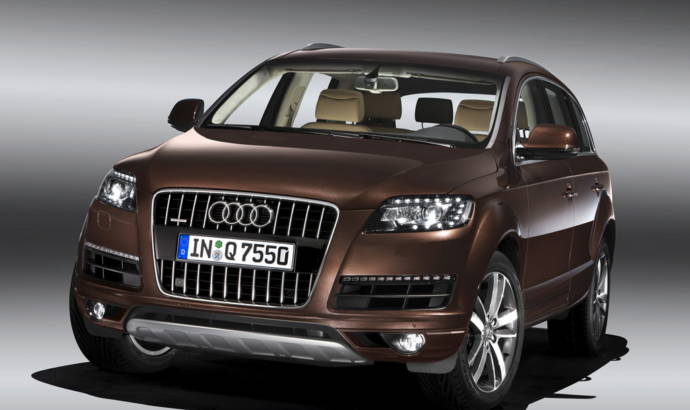
14 Apr 2009
0

